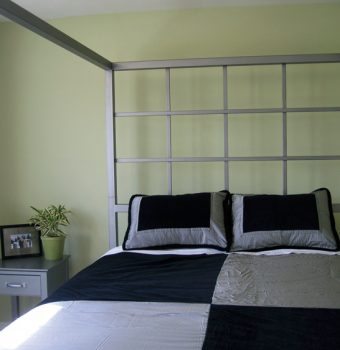
Décor Tips for Urban Living
If you’re looking to give your tired walls at home a facelift or to upgrade that cozy space, spring is a great time to get a fresh new perspective. If you’ve just moved or want to renovate on a budget, where should you start? It may come as a surprise, but you can actually still keep that old piece of furniture you love so much and still give your living space a modern, chic look. There are ways to take a small budget and do big things to revitalize a room. Expert and decorating consultant, Najjia Hawkins, tells us how and gives us the answers to some of the most common decorating challenges.
1. How do I make a space look like a model home?
De-clutter. We all have a tendency of filling a room with too many unnecessary ornaments, furniture, and other day-to-day untidiness. Less is more. Decorative pieces, even as a collection, should be placed strategically in a given place where they look as though they always belonged. CDs, books and crafts should have a home in an armoire or a wall unit where they are invisible.
Painting the walls is a relatively cheap and cheerful way to drastically alter the look of a room.
You can also coordinate accent pieces such as cushions, lamp shades, vases, drapes, paintings, rugs, throws, accenting furniture, towels and so on, in contrasting complementary colours or in a tone-on-tone for a more monochromatic look.
By angling some furniture pieces, you can also de-emphasize a rectangular room and add interest. Soften hard lines of windows with drapes, as simple or sophisticated as you'd like them to be.

2. What are some of the items or decorative elements I should splurge and invest money in?
Pieces like ceiling light fixtures, flooring, updated interior/exterior doors if need be, or countertops if necessary. Tiles for backsplashes or floors, cupboards or vanities, and even something as small and understated as cupboard hardware is worth the money. These architectural elements are details that not only speak volumes about quality in the space, but also enhance the décor and, more importantly, are key for resale value.
3. Can you mix traditional style furniture with contemporary?
Yes. The most ideal balance for this is an 80-20 rule. For example, if you have 80 percent contemporary furniture in a given space, you may incorporate 20 percent traditional pieces.
4. How do I personalize my home to reflect my personality and style?
Add pieces of art, ornaments or accent pieces bought during travels. For example, a Moroccan screen, an oversized silver plate embossed with details, weathered leather chests, and collections of things important to you, are all items that can and should be displayed in the home, on the walls, presented on shelves, or to fill a void corner.
The colours you choose for your home also reflect your personality and taste. If you are questioning what colours you should choose or could live with, then take a look at your wardrobe. Often the colours we wear are ones we are comfortable with seeing around the home.
Furniture style, motifs or patterns in fabrics, wallpapers, rugs, etc., are things one should pay close attention to. Choose items that are a reflection of you. Don't buy items for the sake of filling a space or need.
5. How do I incorporate punchy colours into a room while still keeping it subdued and tasteful?
Allow walls to remain neutral such as tan, beige, grey, cream or any mocha colour. Inject colour in small doses so that you don't tire of it and as well, down the road have the option to change it up season-to-season or year-to-year with relatively little cost. Plants can also be used to not only add colour but to soften a space with their whimsical presence. Accents such as cushions, throws and artwork can also be added. Mosaics, tile/stone and other such materials incorporated into a fireplace and mantle add not only a hint of colour, but also some texture.
6. How do I decide what window treatments to use?
This is a very common question. When deciding on treatments for the window, one must take function into account as well as personal taste.
Factors for functionality are: Keep out direct sunlight – to prevent UV rays from fading fabrics, upholstery and woods (i.e., a Baby Grand next to the window), as well, to keep space cool in the summer months.
Privacy – Fabrics may be used to dress a window, but won't necessarily provide privacy, in which case, installing shutters, venetian blinds or roller blinds in the casement in addition to drapes, can provide function and form.
Room Darkening – In the case of a bedroom, allow yourself treatments which provide aesthetics and give you the option to shut out daylight in the early mornings. For this, any of the blinds mentioned above will work.
Once these issues have been addressed, one can dress the window with fabric as simple or as elegant as your style calls for. Window treatments require research as there are many things to take into account:
- Do you prefer stiff fabrics or ones that drape well?
- Do you like layers, which create a more formal and rich look?
- What sort of motif and patterns on fabric appeal to you?
- What colours?
- Does your budget allow for such a look? (The fuller you want the look, the more fabric required, which in turn means more money.)
- Hardware, such as three inch rods, provide detail and additional style.
Given that there is so much to research, it's best to sift through home style magazines to get ideas. Also, visit fabric stores to see and feel the textures and weight, colour and prints of various fabrics.

7. How can I make a room look larger?
This can be done by using two colours on the walls. For example, use one colour on two adjoining walls and another on the opposite adjoining walls. Another option is to paint one colour on two opposite walls and the other on the secondary opposite walls. Keep paint colours soft and light for an airy feel. Keep window treatments light in visual weight and allow the outdoor view to be seen as this creates implied space.
Plush, oversized furniture can also make a room seem smaller as it takes up more floor space. Therefore, choose furniture on a smaller scale. As well, purchasing glass surfaces for dinner tables, coffee or end tables will allow transparency and present a lighter visual weight, which in turn allows the space to feel larger than it really is. Finally, fewer pieces in the room provide spaciousness.
8. I like mirrors, how can I use mirrors in my home?
Mirrors are really great items to use. The most important thing to know, however, is what is being reflected in the mirror. If it's reflecting a beautiful garden in your backyard, pillars or a nice painting, that's ideal. If it's just reflecting another wall, the purpose is lost. Mirrors in a hallway tend to be a distraction, so they need to be placed strategically. They should be proportionate to the wall including the height of the wall.
9. How do I decide whether or not to put mouldings on a ceiling?
Again, sometimes less is more. You don't necessarily have to put mouldings in every room, and if you really want mouldings, put them in a living room. In areas where there are high ceilings you'll need larger mouldings. Whatever choice you make, mouldings should be in proportion with a room's height, otherwise, you won’t be able to see them and they will get drowned out.
10. How do I decide when to bring in an expert such as a decorator?
Call the experts when your house has been done in a style based on previous owners’ tastes that you just can’t get past, or when you've taken the liberty to decorate yourself and the place still looks like a circus, or you simply don't have the time nor the inclination.
Decorators/designers have a trained artistic eye. They are skilled and have great resources given the nature of their job to pull a space together. Upon seeing a room and proposing and finalizing an idea, theme or scheme, they have a clear vision of what the end result would look like before the task has even begun. A decorator’s expertise allows the project to come to completion with little or no complication.
Clients should try and do some homework so they have some ideas of what style they like and/or what they cannot live with. Flipping through magazines is always a good idea, as it can give you instant visuals to pick and choose from. If you have fabric swatches or samples of materials that you'd like to incorporate into the space, it is always a good idea to present those in the initial meeting or consultation.
INTERVIEW ANJUM CHOUDHRY
For more information or to make an appointment with Najjia Hawkins of Spectrum of Style, email [email protected].














































































































